News
Recent and coming treats for gardeners!
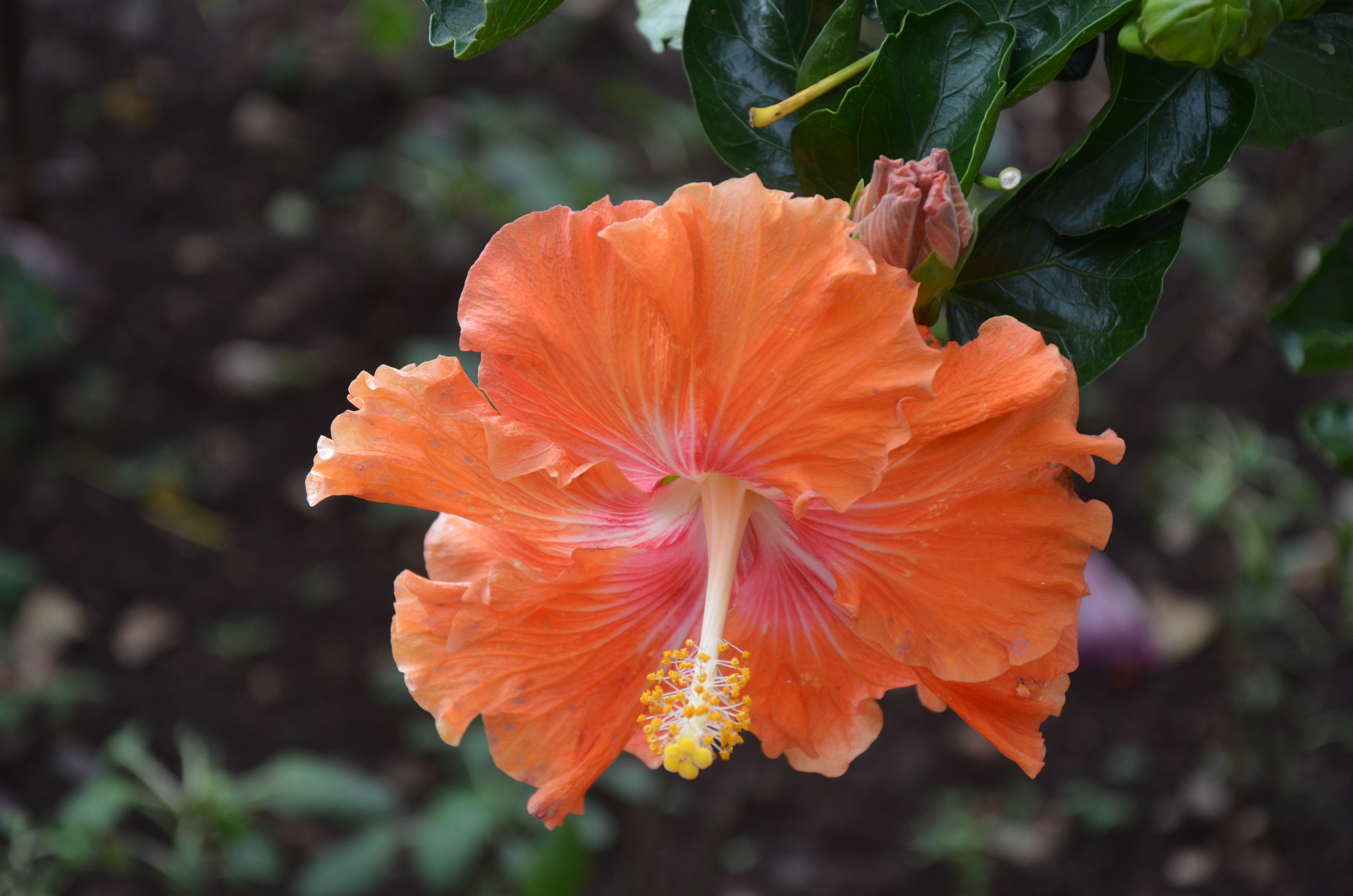 Haslemere Gardening Society was formed in 1947 to promote the cultivation and appreciation of gardens and gardening.
The Society has the same aims today, encouraging gardening for all ages by holding talks and outings to notable gardens
throughout the year.
Haslemere Gardening Society was formed in 1947 to promote the cultivation and appreciation of gardens and gardening.
The Society has the same aims today, encouraging gardening for all ages by holding talks and outings to notable gardens
throughout the year.
Please click here for the 2024 Programme
Our talk on Wednesday 24th April 2024 was on "How I Grow Dahlias - (and learn from my mistakes!)" from Darren Everest, sweet pea and dahlia specialist grower and show exhibitor.
On Wednesday, 28th February 2024 members of the Haslemere Gardening Society and a good many visitors gathered at the Catholic Church Hall to hear a talk by Nick Bailey, the garden designer and frequent presenter on Gardeners' World, entitled "365 days of Colour." He started by telling us that he could give us some tips on getting twice the colour by doing only half of the work if we pruned things like late flowering clematis and dogwoods only every other year instead of as usual each early Spring. That was a good start when gardening in this cold and wet time of the year is not attractive to most people. He told us that earlier in his career he had worked at the Chelsea Physic Garden and about their microclimate where they have the tallest Olive tree in the country at 15m. and the most Northerly fruiting grapefruit.
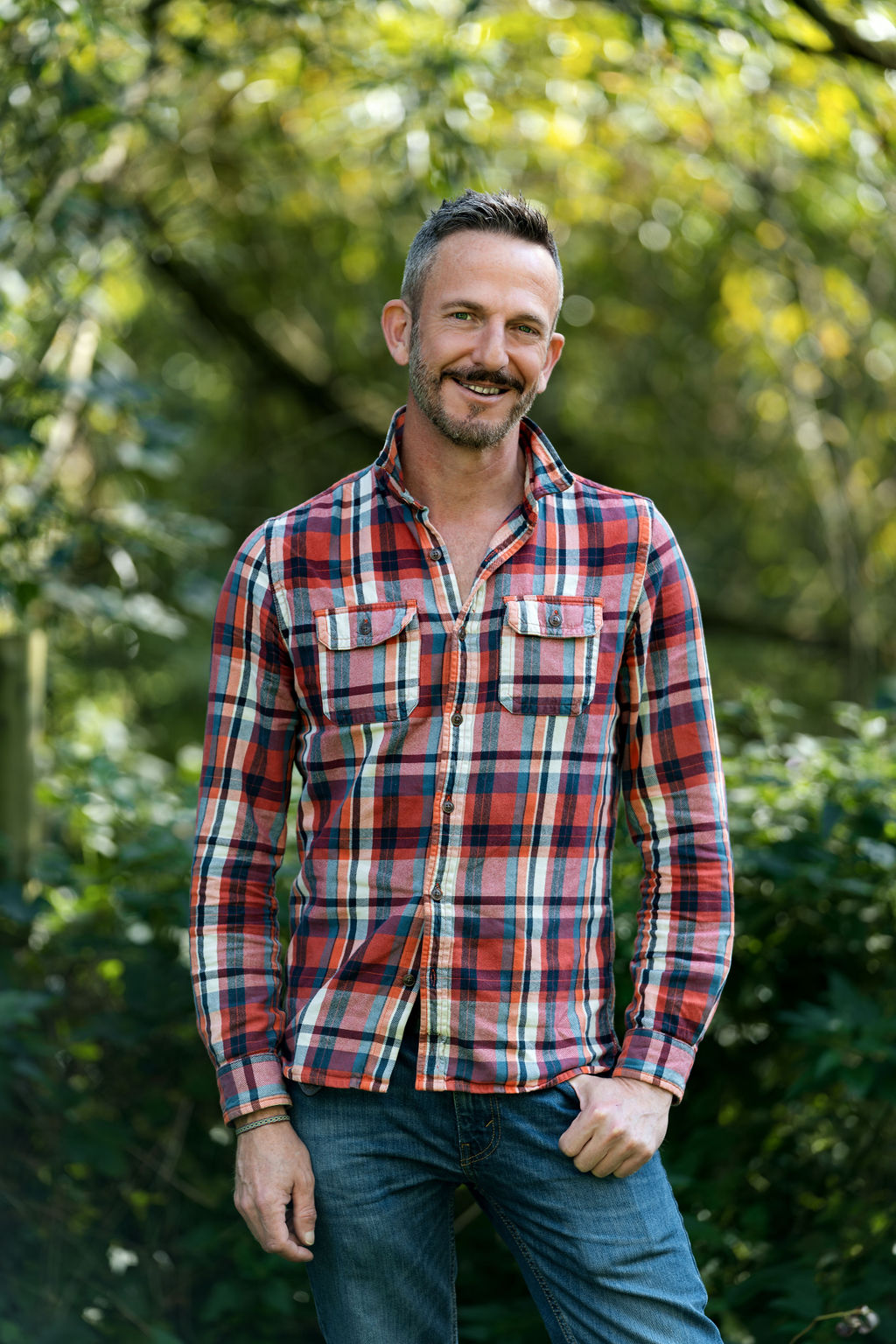 Back to the subject of the evening, Nick talked about the colour wheel and combining colours in the opposite spectrum, balancing contrasting shades with the inclusion of white and remembering that the most permanent colour in the garden is green and pointing out how many attractive shades, shapes and textures can be had from this one colour.
He stressed that the flowering times of perennials like lupins and delphiniums can be extended by deadheading just before the spike of flowers is finished, by altering flowering time by giving plants the "Chelsea Chop", successional sowing of hardy annuals, or even sowing in the Autumn to get earlier flowers next year.
He mentioned planting shrubs with bright foliage and Autumn colour to give a year-round interest and several plants that could be relied on to give at least six months pleasure including Heuchera Peach Flambe and Geum Totally Tangerine. Which incidentally were tones of his favourite colour - orange.
The evening ended with time for a glass of wine and light refreshments, a chance to catch up with friends and to purchase Nick's book which is entitled "365 Days of Colour".
.
Back to the subject of the evening, Nick talked about the colour wheel and combining colours in the opposite spectrum, balancing contrasting shades with the inclusion of white and remembering that the most permanent colour in the garden is green and pointing out how many attractive shades, shapes and textures can be had from this one colour.
He stressed that the flowering times of perennials like lupins and delphiniums can be extended by deadheading just before the spike of flowers is finished, by altering flowering time by giving plants the "Chelsea Chop", successional sowing of hardy annuals, or even sowing in the Autumn to get earlier flowers next year.
He mentioned planting shrubs with bright foliage and Autumn colour to give a year-round interest and several plants that could be relied on to give at least six months pleasure including Heuchera Peach Flambe and Geum Totally Tangerine. Which incidentally were tones of his favourite colour - orange.
The evening ended with time for a glass of wine and light refreshments, a chance to catch up with friends and to purchase Nick's book which is entitled "365 Days of Colour".
.The AGM of the Haslemere Gardening Society was held on Wednesday, 24th January 2024 at the Catholic Church Hall. When the members of the Committee arrived, they were delighted to find that the caretaker had already got out chairs and tables, for this they were very grateful so they could get out the paper work and set up the finger buffet before the members started to arrive. We were lucky that it was a fine mild evening after the two storms there had been earlier in the week and the Meeting was very well attended. The Chairman welcomed so many members and read out some apologies then handed over to Georgina to report on the last year's activities and those to come in 2024. The Treasurer's Report was given by Anthony and all the reports were approved and seconded and the members of the Committee were then re-elected and David asked for any member who had some spare time to perhaps consider volunteering to join as there were always plenty of tasks to be shared. Madeleine Boxall, the President, thanked all the Committee Members for the time and energy they had put in over the year and the business of the meeting was closed. Everyone then adjourned to the side room where a tasty spread of finger food, brought by the members, and a glass of wine were on offer and there was time to enjoy these and socialise before the evening's speaker was ready to talk. This year we were lucky to get David Elliott, the Lead Ranger for the South Downs West National Park to talk to us, and he gave us a most interesting insight into the reintroduction of Beavers to Haslemere and how the whole ecological profile of the area is intertwined. He talked firstly of how the amount of wildlife - birds, beasts, insects and native flowers has declined since we were young and the efforts being made to re-establish many species and the hope that having the beavers working on the river will help to increase the bio-diversity in the area. He told us about beavers and their habits. They are about the size of a labrador dog but with short legs, they are vegetarians so in the wild are no threat to otters or the fish they eat. They are mostly nocturnal but if about in the daytime unlikely to show themselves to us, their predators, who made this native species extinct in our country for 400 years. If you are walking near the river and hear a loud splash it is likely to be a beaver's large wide tail warning you to keep away. Beavers live around 12 years, the first two spent in the family group. They breed once a year in Spring and usually have between 2 and 4 kits. He did mention one female beaver in particular who they are trying to trap to send to much bigger territory in Scotland, when she can be encouraged to enter the transportation cage. It seems she has a serial habit of killing the males and has no intention of breeding. She came from Nep Estate, where in her wake there was one dead male beaver. Suspicious! I think she could be a subject for Lucy Worsey's Lady Killers on Radio 4. He stressed the improvement in the water quality of our rivers when beavers are present and the fact that they create dams upstream helps to reduce the flooding further down the river. The polluted rivers and flooded fields are things we are hearing a lot about now. David finished by saying he knows not everyone agrees with his views but his wish is to see beavers not in restricted areas but free to build their dams and make their homes where they want to as in the long distant past. It was a very enjoyable evening and the members left looking forward to the next talk which is on 28th February by Nick Bailey of Gardeners' World entitled "365 days of Colour". Tickets for this have to be bought in advance as there is a limit on numbers in the Catholic Church Hall.
On Wednesday 13th December 2023 the Haslemere Gardening Society ran a Christmas Outing to the
Wisley Christmas Lights. We had a chance to experience the RHS Gardens in a whole new light,
the twinkling winter walks were unique and highlighted some of the season's most spectacular sights after dark.
On Wednesday 22nd November 2023 members of the Haslemere Gardening Society and friends met for the last time this
year at the Catholic Church Hall in Derby Road to listen to a talk from David Standing entitled "Cottage Gardening". David is the retired Head Gardener at Gilbert White's Garden in Selborne, where he worked for many years, after having quickly decided that his intended profession in Town Planning and working in an office was not for him. He started there in 1979 doing odd jobs for £1.25p an hour but was promoted later to Head Gardener and eventually left the post in 2017.
He started the talk by saying that Cottage Gardening was a mixed and personal concept, being rustic and featuring plants from Old Roses, hollyhocks, shrubs, perennials to bedding plants and sometimes with vegetables mixed in. Many of the plants used are self-seeding and so a very informal look is achieved. To get the desired effect the border needs to be as deep as possible and divided by paths of either local stone or even better foraged bricks. Of course, the effect is more picturesque if you happen to have a cottage with a thatched roof but as this isn't possible for all, the Cottage Garden look can be achieved with a pleasing mixture of 'old fashioned' cultivars which are allowed to fill the space quite randomly. The look is more plants jostling each other than set out with space between them. He brought with him, for sale, some seedlings which he finds work well including sweet rocket, campanula and yellow foxgloves. As it was approaching Black Friday, they were a special price and were quickly snapped up with thoughts of exciting things happening in our gardens next year.
The talk was very well attended and the tea, coffee and biscuits provided were enjoyed while we chatted and discussed plans for Christmas.
On Wednesday 25th October 2023 the members of the Haslemere Gardening Society gathered for the second talk of the Autumn in the Catholic Church Hall in Derby Road as usual. This time the subject was "Fruit for a Small Garden" and was given by Jim Arbury, Fruit and Trials Specialist at the RHS, so it was a very informative and useful evening for us amateurs. It was followed by sociable tea, coffee and biscuits.
On Wednesday, 27th September 2023, members of the Haslemere Gardening Society gathered at the Catholic Church Hall for the first lecture of the Autumn Season. This year we started with a talk by Paul Gallivan on the local garden of Woolbeding just outside Midhurst. Paul knows the garden very well as he was head gardener there for more than 13 years working for the National Trust who now own the property. He is no longer there as he has been promoted to Regional Garden Consultant for the charity. He started by telling us about the history of Woolbeding from the 18th century to the present day when it was given to the NT in 1957 by the then owner Edward Ponsonby Lascelles and later let to Simon Sainsbury and his partner Stewart Grimshaw who transformed the interior of the house while leaving the exterior and the approach recognisable from early paintings and photographs. The colours in the garden are kept to a pallet of mainly blue and white with a little touch of yellow now and then and the Victorian bedding has been replaced by perennial herbaceous borders in those colours. The vegetable garden is caged against thieving wildlife and the damage from slugs is lessened by beer traps and nematodes. No chemicals are used there. Sadly, the old cedar tree in the centre of the lawn, after storm damage. had to be removed but was replaced by an amazing Water Feature like a Champagne saucer which was made in Essex and is a focal point of the garden. Recently a new and very modern glass house has been added to the garden, looking a bit like the nose cone of a rocket as it opens. Leaving the formal parts of the garden there is a walk by the river Rother to follies including a " ruined abbey" and a grotto featuring a large figure of Neptune. The garden is now closed until next April and has to be booked through the NT during the open season as there is no private vehicle entrance allowed, but is well worth a visit and with the added bonus of a tasty sandwich or cake from the cafe. It was a very enjoyable evening and we thank Paul for his time and enthusiasm. The next talk will be on Fruit for a Small Garden by Jim Arbury who is Fruit and Trials Specialist at the RHS and is on 25th October. .
With all the regular summer activities such as Wimbledon and the Hampton Court Palace Garden Festival being in full swing, it was time on Wednesday, 12th July,for the members of the Haslemere Gardening Society to enjoy the second outing of the year. This time it was fairly local, being to Upton Grey Manor House in Hampshire. This very special garden designed by Gertrude Jekyll in 1908 for Charles Holme, a leading figure in the Arts and Crafts Movement, was bought by John and Rosamond Wallinger in 1984, the house being almost derelict and the garden a jungle. They were novice gardeners but were given the help and advice of Penelope Hobhouse and acquired copies of Miss Jekyll's original plans from Berkley University in California and with a great deal of hard work restored the garden to its present glorious state with the plants intended by the designer. The colour scheme in most of the formal beds was predominantly shades of pink and white backed by many magnificent hollyhocks. Besides the formal beds at the rear of the manor there was a nuttery leading to the wilder part at the front with a lovely lily pond. To the other side of the house is a well-stocked kitchen garden inhabited by a flock of hens. We were made very welcome by Rosamund and John Wallinger, the former giving us an interesting talk on the garden and then offering us tea, coffee and cake before we explored. It was lovely to get such a personal introduction to the garden. We left Upton Grey at around 1pm and headed to West Green House where lunch was available, served on chinaware decorated with pictures of the very pretty manor house. The garden is divided by a series of box hedges which seem to have survived both box blight and moth infestation and contained lots of roses, perennial plants and annuals as well as some amazingly whole rows of frilly lettuce. Does someone pop out and replace them every morning before the visitors arrive? Just as we were having tea the rain came down but we were extremely lucky to have had such a fine day in the midst of a rather damp and chilly July. Thank you to Georgina for arranging this and all the other outings for us and to Kenny, our driver, for a pleasant journey there and back and his skill at negotiating the very narrow lanes with the various parked hazards. It was a lovely day out.
During a busy week for members of the Haslemere Gardening Society, we were firstly up early on Tuesday 13th June 2023 to board the coach for the Cotswolds. It was quite a long journey but well worth the effort. We arrived at Sudeley Castle Gardens just after 11am and had plenty of time to explore. There was much to see including formal gardens with lovely roses, borders containing nepeta and other bee friendly plants, the ruins of a banqueting hall once owned by Richard III, the tomb of Henry VIII's last wife Catherine Parr and a selection of wild animals along the paths, very realistically made mostly of willow. I loved the elephants they looked so natural and free. After a chance for lunch and a drink in the cafe we were off again to Sezincote House and Gardens, a very different venue from the castle. We were lucky to have the garden specially opened for the Society and were given a tour around the house in small groups. The house was built in the late 18th century having been a whim of Col. John Cockerell on his return from years in India. Sadly, he died before it could be done but his wishes were carried out by his brother Charles who inherited the property. It is said to be the inspiration for the Brighton Pavilion after the Prince Regent's visit in 1807. The garden was divided into two separate areas with the formal Persian garden and orangery at one side of the house, and to the other a water garden with streams planted with rare damp loving plants and stepping stones under the drive bridge to grassy mounds and more trickling streams. On a very hot day it was quite enchanting. We were sad to leave such a lovely spot but were very grateful to Georgina for arranging it all and to Steve our driver for the smooth and comfortable journey. Then on Saturday 17th June it was the Society's annual coffee morning held each year in one of the member's gardens. I would like to say the garden rivalled the ones we had visited in the week for its spectacular planting and beauty, but I can't because it was my garden. All I can say is that I had worked hard and carried many cans of water to keep the flowers, shrubs and vegetables alive over the five weeks of no rain and most were not looking too parched and the terracing and steps done by Sean who does the heavy work were very much admired. Sadly, the two pond levels were well down but still enough water in them for the numerous newts and tadpoles. As always tea, coffee and cake were much enjoyed and the plant sale was very popular. Thank you everyone for coming and saying such nice things about my garden it was lovely to welcome you all. As I am finishing this report, we have had heavy, long awaited and much appreciated rain in the early hours. It's great, but I am so glad it wasn't last Tuesday or Saturday and am very grateful to whoever controls the weather. Thank you!
Helen French .
On Wednesday 26th April 2023 members of the Haslemere Gardening Society met in the Catholic Church Hall in Derby Road for a most interesting talk by Darren Everest on the growing of sweet peas. Darren is a champion grower of this ever-popular summer garden plant and he has won many gold medals with them and this year is exhibiting at Chelsea Flower Show. He told us that he always sows his first lot of seeds in October which is good when it is a cold Winter but if it is mild, they are inclined to be ready for the outdoors before their right time, so he aims to sow a second batch between November and January. He advocates watering once and warns that they need to be protected from mice who love them. As they grow, he advised pinching out the growing tip and planting them out in a square frame and not a wigwam as they like to fan out and not go up to a point. He told us about the time he had been filmed for TV, demonstrating how to produce winning plants and the repeated takes from different angles there had to be to get the perfect picture for the viewers. Darren had brought some sweet pea seedlings with him for sale and they were purchased enthusiastically by the members. The evening finished with tea, coffee and biscuits and we all wish Darren good luck with his preparations and a successful time at the Chelsea Flower Show.
On Wednesday 22, March 2023, members of the Haslemere Gardening Society and guests gathered for the monthly talk at the Catholic Church Hall in Derby Road. Although it was a wet and windy evening a lot of people turned out to hear the lecture by Dr. Peter Herring entitled "Magnificent Magnolias". Simon in introducing Dr. Herring started by apologising for advertising him as Head Gardener at Winkworth Arboretum instead of Enthusiastic Volunteer there. Dr. Herring accepted the apology and said the real head gardener had forgiven us. Peter started by telling us about the origin of magnolias and saying that they were first introduced to this country in 1689 and came from the Americas and later selections arrived from the Far East. The specimens were propagated and the stock increased by layering in the early days as the magnolia has pollen and not nectar to attract the bees and needed pollinating beetles. He talked about the many differing types of magnolias from the large evergreen magnolia grandiflora to the small deciduous magnolia stellata with its delicate star-shaped flowers. Some of the most popular and those just coming out in local gardens are the hybrids of the magnolia soulangiana, most of which are white and shades of pink and purple. In more recent years yellow varieties have been developed. The magnolias blooming at this time in the Spring are often subject to late frosts damaging the flowers but Peter said there are varieties that come into flower in early Summer when the risk of frost is over. After the talk there were questions from the floor and Simon thanked Peter for his inspiring talk and sharing his knowledge and enthusiasm with us. Tea, coffee and biscuits were served and there was a chance to catch up on friends' news and arrange to see each other again at the next talk which will be about sweet peas.
On Wednesday, 22nd February 2023 there was a full house at the Catholic Church Hall of members of the Haslemere Gardening Society and their friends to enjoy a talk by Cherrill Sands entitled "Arts & Crafts Gardens" and we were not disappointed as Cherrill's knowledge on the subject was extensive. She is a consultant garden historian, member of the Painshill Park Trust and Surrey Gardens Trust and has obvious enthusiasm for her subject. Cherrill started by explaining to us that the Arts and Crafts movement began in the 1850s when already half the population lived in cities and had little access to green spaces. At the time most public parks and gardens were filled with bright coloured annual bedding plants in geometrically arranged beds and people like William Morris and his long time collaborator Philip Webb wanted gardens to be filled with more sustainable plants in paler and more romantic colours. Together they built many outstanding houses with surrounding gardens laid out on the principal of a straight path with garden "rooms" of croquet lawns, pool gardens, vegetables and orchards all joined by paths with pergolars and climbing plants. They were also in favour of trellises on sides of their houses with climbing plants softening the appearance. These ideas can also be seen in the designs for fabric and wallpaper by William Morris. The houses were often placed at the top of a hill so that the views from inside were inspiring. One such is Standen, which was visited members of the Society in 2019. Cherrill also mentioned Gravetree Manor in Sussex, now a hotel, which was laid out by William Robinson with lots of trees, natural plantings with meadows of wild flowers allowing things to self seed. Of course, Arts and Crafts could not be discussed without talking about the most famous garden designer of the era, Gertrude Jekyll, and her house Munstead Wood in Godalming. Again the design is for a long and colourful herbaceous border and "rooms" which feature different aspects of gardening. Unlike William Morriis, Miss Jekyll was very keen on bright colours but with white flowers in the beds with them I wondered whether this was because her eyesight was failing and the brighter shades were more pleasurable to her, or perhaps she thought it was time for a change from the colours of the previous quarter century.s She designed many gardens with the architect Edwin Lutyens including the one at the Manor House, Upton Grey, which is where members of the Society will be going in July. The last designer she talked about was Christopher Lloyd and his garden at Great Dixter which is such a joy to visit, particularly in high and late Summer when the colourful plants are in their full and exuberant glory. It was a very enjoyable evening and I am sure we would all like to thank Cherrill for sharing her knowlege and obvious passion with us.
As a break from our traditional Christmas Dinner, on Wednesday 14th December members of the Haslemere Gardening Society took the coach to Kew Gardens for a trip to see the annual "Christmas at Kew" lights. It was one of the coldest evenings so far this year but there were hot drinks and festive foods to be purchased on the way round the gardens to warm us from inside. We were all prepared for the cold and well wrapped up and everyone enjoyed the spectacular lighting effects. There were snowflakes projected onto the paths, dancing lights on the lakes and trees wrapped in hundreds of sparkling lights. The tour of the the garden's display was easily completed in the almost three hours we had there so there was plenty of time to browse in the shops or sit in one of the cafes for a cup of tea and sample the delicious cakes on offer. It was a truly magical evening with not only beautiful and spectacular lights accompanied by Christmas music but also a lovely clear sky and no rain or wind meant that the natural joys of a mid-winter night could also be enjoyed. A big "thank you" to David for thinking of it and to Georgina for organizing another outing so efficiently. Our thanks also to Steve the driver of the coach for getting us there and back so comfortably and on time. It was a great start to the Christmas festivities.
On Wednesday the 23rd of November 2022 the Society held its final talk of the year at the Catholic Church Hall. The subject was "Shrubs - The Backbone of your Garden" and was given by Geoff Hawkins, lecturer, broadcaster and retired Head Gardener at Mill Court. His illustrated talk gave us some ideas of which shrubs we could use in our garden to give structure, shape and texture as well as colour through flowers, stems and foliage. He advised starting with a good garden design, remembering that shrubs are there all the time, a constant through the changing seasons, so it is important "to get it right". Proportion is vital, as is pruning that retains the natural shape- no "lollipops"! Pruning should be done properly; (it is best not to have a shrub that must be pruned all the time) and going under the shrub to do so is sometimes best. He went through the alphabet and described a richly varied selection of shrubs, all illustrated in slides, and demonstrated their versatility. It was a very enjoyable and informative talk and was attended by many members of the Society and guests.
Georgina reminded us that the AGM would on Wednesday 25th January at 7.45 in the Catholic Hall and that the outing to Kew on the 14th of December was now fully booked.
On Wednesday, 26th October 2022, members of the Haslemere Gardening Society were gathered once more in the Catholic Church Hall in Derby Road for a talk given by Chris Stewart on the Fascinating and Secret Life of the Mole. Chris is a member of the Guild of British Molecatchers, and although his job is obviously to catch and get rid of the little animals, he shared a great many interesting facts about them with his audience. He said although we are inclined to associate Moles with the sweet little fellow in the Wind and the Willows, they are not to be handled without care because they have very sharp teeth. Moles are very much loners who live around 3 years and only produce one litter of usually 6 or 7 kits a year. They are very territorial creatures and will fight to defend their space and as soon as one is removed another very quickly moves into the prepared tunnels. In days past there were many supposed deterrents against moles including putting human hair in the tunnels, but one of the strangest was planting euphorbias in the garden thinking that as the white sap from the plants was used to treat moles on the skin it would also work against moles in the garden. Neither of these actions were of any use. Chris brought with him two stuffed moles, a male and a smaller female, both very tiny considering the amount of soil they can move, some mole pelts for us to feel their softness and a selection of homemade and manufactured traps. Many of the traps are not legal in this country as, happily only humane traps are allowed here. We were probably divided in the hall as to whether to try to eliminate the little creatures from our patch or let them be. I am, personally, on the live and let live side, but perhaps that is because I have never had the type of garden moles prefer. If I did have, I might feel about them the way I feel about slugs in my vegetables. It was certainly a very interesting evening and very well attended. It is hard to believe there is only one more talk this year, on the 23rd of November entitled 'Shrubs: the backbone of your Garden' to be given by Geoff Hawkins, retired Head Gardener at Mill Court.
The first talk of the Autumn took place at the Catholic Church Hall on Wednesday, 28th September 2022 and was given by Mark Saunders who has been the head gardener at Fittleworth House for 25 years. It featured the ten most important tips that Mark wanted to give us for success in our own gardens. The first and of premier importance was 'look after your tools, keep them clean, sharpened and oiled '. This is particularly important with secateurs, making them easier to use and kinder to the plants. His next tip was to stay active. For this he recommends Yoga and demonstrated some positions for us. Sadly, none of the audience got up to join him. Well, we weren't dressed for it. Mark also talked about the importance of compost making and stressed that it did need turning regularly and on adding more materials for the best results. He recommended a trip to RHS Wisley to see their beautiful Winter Garden and suggested that if we plant items for interest in the colder parts of the year, we did so near the house to get the full benefit from them. He talked about the usefulness of pots which can be swapped around to improve the display as they peak and then die-off. Mark, as well as a gardener is known for his brilliant photography, which was very obvious from the slides he showed us. There were pictures of his own garden, Fittleworth House, an exuberant display of pots at Great Dixter and the avenue of Tree Ferns at East Rushton Old Vicarage among many others. It was a very enjoyable and informative talk and was attended by many members of the Society. Simon reminded us of the next lecture which will be on the' Fascinating and Secret Life of the Mole' on Wednesday, 26th October 2022 and given by Chris Stewart, a Member of the Guild of Molecatchers. A very different subject.
With Summer officially over the members of the Haslemere Gardening Society
were getting together for a series of talks on various subjects, mostly to do with gardening but sometimes on
related subjects.
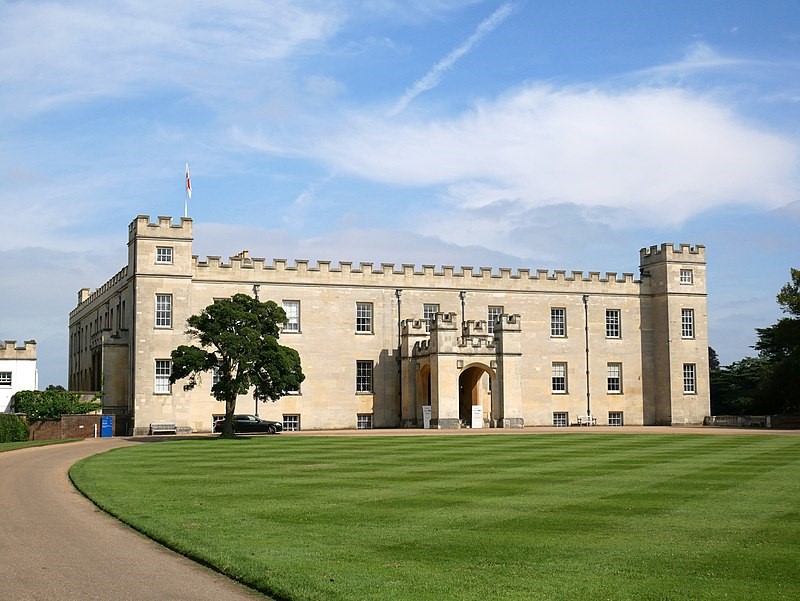
We were taken on a guided tour of the House by a very well-informed and interesting young lady who pointed out the architecture designed by Robert Adams and all the many portraits of members of the Percy Family and the many famous people who had visited there. The house is built on the site of Syon Abbey and after the dissolution of the monasteries by Henry VIII and Edward VI the present house with its white exterior was built by Edward Seymour, the Lord Protector and when he was executed acquired by the Duke of Northumberland and it has been in the same family ever since. It was there that Lady Jane Grey was offered the crown on Edward VI's death. After the Jacobean era and the civil war, the Estate was inherited by Sir Hugh Smithson who was created 1st Earl and Duke of Northumberland and it was then that the interior of the house was transformed into an amazing and beautiful place that we can visit today. It reflects the wealth of the leading families of the time with its Doric columns, statuary and walls adorned with so many masterpieces.
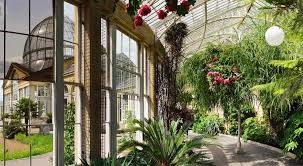 After we toured the house, we had the option of walking around the acres of gardens with the centrepiece of the
Great Conservatory with its lily pond and collection of exotic plants or going first into the associated
Hilliers Garden Centre for refreshment.
After we toured the house, we had the option of walking around the acres of gardens with the centrepiece of the
Great Conservatory with its lily pond and collection of exotic plants or going first into the associated
Hilliers Garden Centre for refreshment.
We had missed the large wildflower meadow by one week as it had come to the time for cutting but there was a smaller area devoted to native hedgerow plants near the Conservatory which was alive with bees. It is wonderful to see so many acres of green so near to the centre of London and know that it has been like that for many centuries. Before boarding the coach for home many of us visited the Garden Centre which had a tempting display of plants and quite a few of us went home with at least one souvenir of the visit. Our thanks to Georgina for organising another great day out and to Steve the driver for his good care of us. With Summer sadly now behind us it is time to look forward to the Autumn Lectures at the Catholic Church Hall in Derby Road. The first one on 28th September 2022 is by Mark Saunders who is a writer and photographer and Head Gardener at Fittleworth House and starts as usual at 7.45 pm. This promises to be a very interesting talk and is free to members and just £2 for visitors. Tea, coffee and biscuits will be on offer at the end of the evening and we look forward to seeing many members and their friends.
It was a busy June for members of the Haslemere Gardening Society with two events within a week. On Saturday 11th June 2022 the annual Coffee Morning was held in the beautiful secluded garden of our President Madelaine Boxall. It was a lovely sunny day, not too hot, and when members began to arrive at around 10am the Committee and some helpers had laid out the tea, coffee and a delicious selection of cakes and the plant stall with lots of interesting small and large items for sale. The garden looked immaculate with beautiful roses in full bloom, colourful herbaceous borders and hostas with not a slug hole in site. The event was well attended and the sale of many plants boosted the Society's Bank balance. A big 'thank you' to Madelaine for her hospitality and to all those who helped to make the morning such a success.
On the following Wednesday 15th June 2022, we were off on the second coach outing of the year to Cliveden Gardens and Bledlow Manor Gardens. This outing was originally planned for 2020 and had been postponed twice due to Covid and re-arranged by Georgina. This time it went ahead but sadly without its organiser who was not well enough to come. Regrettably several members of the Committee were also unwell and Madelaine stepped into the breach keeping us in order and shepherding us on and off the coach at the right times. We arrived at Cliveden Gardens after a trouble-free journey and had 3 hours to explore. It was a beautiful Summer's day and there was plenty to look at and admire. Looking over the South Terrace we could see the extensive parterre laid out beneath us. Sadly, the alliums which had filled it were now finished and we were told that the gardeners were having a lot of trouble with rabbits eating the young plants. In the distance was a view of the Thames and those who walked down to the river were able to take advantage of a boat trip between the two locks. Very tempting on such a lovely hot day. There were so many red kites flying overhead and the boatman warned that they are now becoming like seagulls and pinching food from picnickers' hands but with the added advantage, to them, of large sharp talons. After climbing back up the hill the rose garden was not to be missed and the herbaceous border, just coming into full flower, was interesting particularly looking at the way the plants were supported with woven twigs.
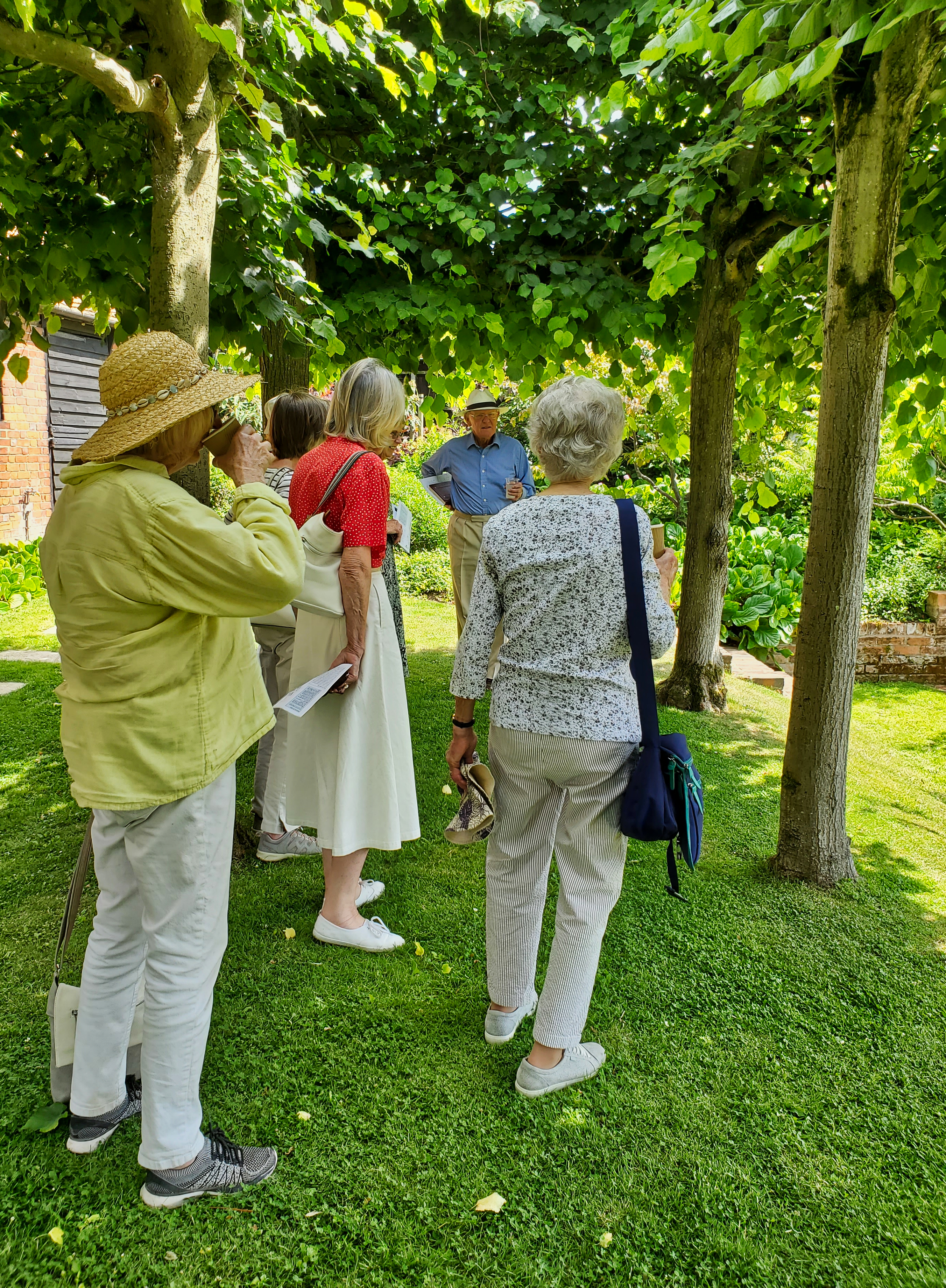 At 1.30pm we were off again and this time to a very different garden, that of Lord Carrington. It was a delightful experience in every way. We were treated to tea and very tasty cakes on arrival at Bledlow Manor and then Lord Carrington told us about the garden's history and design and took us on a tour himself. It was obviously a much loved and personal place for him and a joy to be allowed to admire it. The garden is divided into different 'rooms' each brimming with flowers. There was an alpine garden where we were warned to watch where we put our feet as in between the paving stones were lovely little treasures. Roses were a strong feature in most of the gardens and seemed to be having a good year. There is a sculpture garden which is very interesting and formal ponds with vegetable dye in them to make them look deeper. The afternoon ended with a walk around the Lyde Gardens, which is open to the public and goes down into a valley with narrow walkways and paths and interesting trees and shrubs with a stream running through it.
We were all very grateful to Lord Carrington for allowing us to see his beautiful garden and for sparing the time to share it with us.
The journey home was smooth and uneventful and once again we all thanked Steve, who seems now to be our regular driver, for a pleasant and comfortable trip. Thanks were also sent to Georgina for organising it all and wishes for a speedy recovery
At 1.30pm we were off again and this time to a very different garden, that of Lord Carrington. It was a delightful experience in every way. We were treated to tea and very tasty cakes on arrival at Bledlow Manor and then Lord Carrington told us about the garden's history and design and took us on a tour himself. It was obviously a much loved and personal place for him and a joy to be allowed to admire it. The garden is divided into different 'rooms' each brimming with flowers. There was an alpine garden where we were warned to watch where we put our feet as in between the paving stones were lovely little treasures. Roses were a strong feature in most of the gardens and seemed to be having a good year. There is a sculpture garden which is very interesting and formal ponds with vegetable dye in them to make them look deeper. The afternoon ended with a walk around the Lyde Gardens, which is open to the public and goes down into a valley with narrow walkways and paths and interesting trees and shrubs with a stream running through it.
We were all very grateful to Lord Carrington for allowing us to see his beautiful garden and for sparing the time to share it with us.
The journey home was smooth and uneventful and once again we all thanked Steve, who seems now to be our regular driver, for a pleasant and comfortable trip. Thanks were also sent to Georgina for organising it all and wishes for a speedy recovery
On Friday 6th May members of Haslemere Gardening Society boarded a coach early in the morning to visit the first RHS Flower Show of the year at the 3 Counties Showground in Malvern. The journey went well until the last 7 miles where a new roundabout was being constructed and that took us an hour.
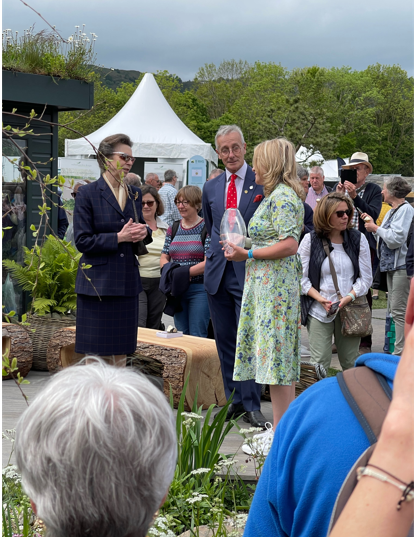
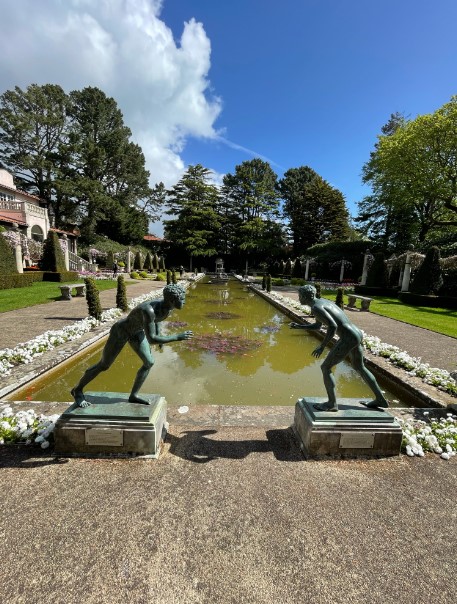 The coach set
off from Haslemere Hall at 8.30 am en route for Compton Acres in Poole, Dorset,
a privately owned garden set on a steep hill and including a wooded valley.
The weather was very much better than had been forecast with some lovely sunny spells making
The coach set
off from Haslemere Hall at 8.30 am en route for Compton Acres in Poole, Dorset,
a privately owned garden set on a steep hill and including a wooded valley.
The weather was very much better than had been forecast with some lovely sunny spells making
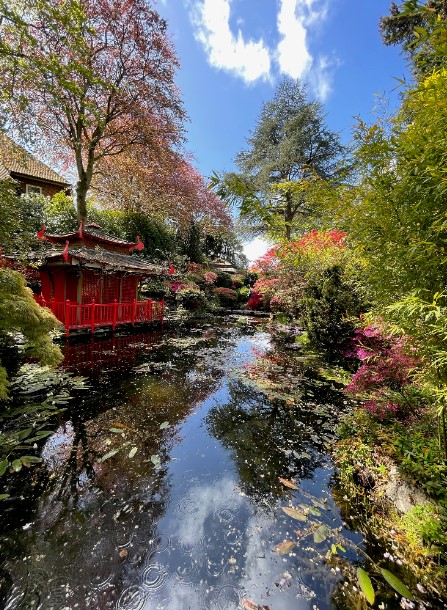 exploring
the many and varied elements of the garden very enjoyable. Each corner held a new and delightful view where the plants
seemed to have been placed exactly in the right place.
exploring
the many and varied elements of the garden very enjoyable. Each corner held a new and delightful view where the plants
seemed to have been placed exactly in the right place.